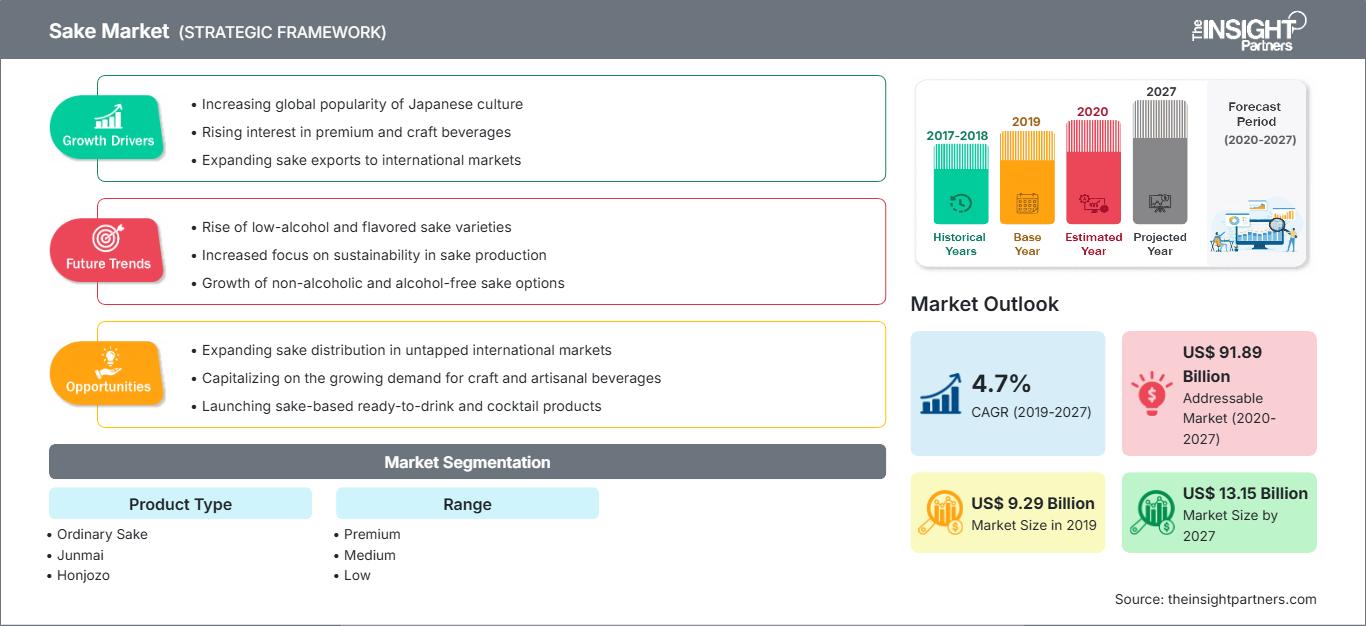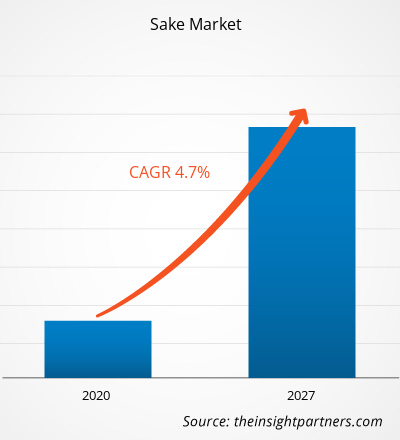El mercado del sake se valoró en US$ 9.290,16 millones en 2019 y se proyecta que alcance los US$ 13.146,68 millones en 2027; se espera que crezca a una CAGR del 4,7% entre 2020 y 2027.
El sake es una bebida alcohólica japonesa elaborada con arroz fermentado y se conoce como vino de arroz. Generalmente, se elabora con arroz mai (sake mai) pulido, un moho conocido como Aspergillus oryzae, agua y levadura. Los sakes de calidad se añejan durante más de un año y la mayoría de sus variantes tienen un contenido de alcohol por volumen de entre el 15 % y el 20 %.
Se espera que el mercado del sake en Norteamérica alcance su mayor tasa de crecimiento anual compuesto (TCAC) durante el período de pronóstico. Este crecimiento se atribuye principalmente al aumento del consumo de bebidas alcohólicas en Norteamérica. La creciente demanda de bebidas alcohólicas, incluido el sake, se ha visto impulsada por el aumento del número de cervecerías y destilerías en la región. Esta creciente demanda ha atraído a los fabricantes a establecerse en la región, lo que ha impulsado aún más el crecimiento del mercado del sake en Norteamérica. La presencia de empresas consolidadas como Takara Sake USA Inc., Gekkeikan Sake y Ozeki Sake ofrece oportunidades de crecimiento para el mercado del sake en Norteamérica.
Personalice este informe según sus necesidades
Obtendrá personalización en cualquier informe, sin cargo, incluidas partes de este informe o análisis a nivel de país, paquete de datos de Excel, así como también grandes ofertas y descuentos para empresas emergentes y universidades.
Mercado del sake: perspectivas estratégicas

- Obtenga las principales tendencias clave del mercado de este informe.Esta muestra GRATUITA incluirá análisis de datos, desde tendencias del mercado hasta estimaciones y pronósticos.
Impacto de la pandemia de COVID-19 en el mercado del sake
El brote de COVID-19 afecta negativamente a las economías e industrias en varios países debido a confinamientos, prohibiciones de viaje y cierres de negocios. Alimentos y bebidas se encuentran entre las industrias significativas que sufren graves interrupciones, como restricciones en la cadena de suministro y cierre de plantas de producción. El cierre de diferentes plantas y fábricas en varios países interrumpe las cadenas de suministro globales e impacta negativamente las actividades de fabricación, los cronogramas de entrega y las ventas de múltiples bienes. La pandemia de COVID inicialmente interrumpió la demanda de alcohol debido al cierre de restaurantes, proveedores de servicios de comida, licorerías, hoteles y bares, lo que tuvo un impacto negativo en el mercado del sake. El cierre de las tiendas y pubs locales ha generado oportunidades para los proveedores de servicios en línea, lo que ha estabilizado la demanda de bebidas alcohólicas durante el período de la pandemia, lo que ha tenido un impacto positivo en el mercado del sake. Por lo tanto, inicialmente COVID 19 tuvo un impacto negativo en el mercado del sake, pero de forma lenta y constante a medida que aumentaba la demanda de alcohol, llevó a un aumento de la demanda de sake.
Perspectivas del mercado
Aumento de las exportaciones de sake
La disminución de la demanda de sake en Japón, así como en los países de Asia Pacífico, ha provocado un aumento en su exportación. Debido al alto consumo de alcohol y a la gran preferencia por las bebidas tradicionales en Estados Unidos, las exportaciones de sake a este país se han incrementado. El creciente número de restaurantes japoneses en regiones como Europa y Norteamérica ha impulsado un aumento en la demanda de sake. La alta apreciación y la creciente tendencia a combinar diferentes cocinas con sake están impulsando un aumento en la exportación de sake a diversos países.
Información sobre tipos de productos
Según el tipo de producto, el mercado del sake se divide en sake ordinario, junmai, honjozo, junmai ginjo, ginjo y junmai daiginjo. El segmento de sake ordinario representó la mayor cuota de mercado en 2019; mientras que se espera que el segmento de sake junmai registre la mayor tasa de crecimiento anual compuesta (TCAC) entre 2020 y 2027. El sake ordinario, también llamado futsū-shu, es el equivalente a un vino de mesa y representa la mayor parte del sake producido. Según Takara Sake, el sake ordinario representa aproximadamente dos tercios de la producción mundial de sake, con un sabor y cuerpo suaves, un paladar dulce sutil y poca o ninguna acidez. El arroz que se utiliza para elaborar el sake ordinario se pule al 70 % y puede contener o no alcohol de cervecería añadido.
Información sobre el alcance
Según su gama, el mercado del sake se segmenta en premium, medio y bajo. El segmento bajo representó la mayor participación en el mercado en 2019, y se espera que registre la tasa de crecimiento anual compuesta (TCAC) más rápida entre 2020 y 2027. El segmento de precio bajo se elabora para obtener el máximo rendimiento y valor, utilizando arroz de menor calidad, generalmente pulido por debajo del 30 %. La mayor parte del sake producido se encuentra en el segmento de precio bajo.
Entre las empresas que operan en el mercado del sake se encuentran Aramasa Co., Ltd.; Asahishuzo CO., Ltd.; Blue Current Brewery; Gekkeikan Sake Co., Ltd.; Hakutsuru Sake Brewing Co., Ltd.; Kanpai London; Craft Sake; Ozeki Corporation; Sun Masamune Pty Limited; Takara Sake USA Inc.; Tatsuuma-Honke Brewing Co. Ltd., entre muchas otras. Las empresas clave implementan estrategias de fusiones y adquisiciones, así como de investigación y desarrollo, para ampliar su cartera de clientes y obtener una participación significativa en el mercado global, lo que también les permite mantener su marca a nivel mundial.
Perspectivas regionales del mercado del sake
Los analistas de The Insight Partners han explicado detalladamente las tendencias regionales y los factores que influyen en el mercado del sake durante el período de pronóstico. Esta sección también analiza los segmentos y la geografía del mercado del sake en Norteamérica, Europa, Asia Pacífico, Oriente Medio y África, y Sudamérica y Centroamérica.
Alcance del informe del mercado del sake
| Atributo del informe | Detalles |
|---|---|
| Tamaño del mercado en 2019 | US$ 9.29 mil millones |
| Tamaño del mercado en 2027 | US$ 13.15 mil millones |
| CAGR global (2019-2027) | 4,7% |
| Datos históricos | 2017-2018 |
| Período de pronóstico | 2020-2027 |
| Segmentos cubiertos | Por tipo de producto
|
| Regiones y países cubiertos | América del norte
|
| Líderes del mercado y perfiles de empresas clave |
|
Densidad de actores del mercado del sake: comprensión de su impacto en la dinámica empresarial
El mercado del sake está creciendo rápidamente, impulsado por la creciente demanda del consumidor final debido a factores como la evolución de las preferencias del consumidor, los avances tecnológicos y un mayor conocimiento de los beneficios del producto. A medida que aumenta la demanda, las empresas amplían su oferta, innovan para satisfacer las necesidades del consumidor y aprovechan las tendencias emergentes, lo que impulsa aún más el crecimiento del mercado.

- Obtenga una descripción general de los principales actores clave del mercado del sake
Informe destacado
- Tendencias progresivas de la industria en el mercado global del sake para ayudar a los actores a desarrollar estrategias efectivas a largo plazo.
- Estrategias de crecimiento empresarial adoptadas por los mercados desarrollados y en desarrollo
- Análisis cuantitativo del mercado mundial del sake de 2017 a 2027
- Estimación de la demanda mundial de sake en diversas industrias
- Análisis PEST para ilustrar la eficacia de los compradores y proveedores que operan en la industria
- Desarrollos recientes para comprender el escenario competitivo del mercado y la demanda global del sake
- Tendencias y perspectivas del mercado, así como factores que impulsan y restringen el crecimiento del mercado mundial del sake.
- Proceso de toma de decisiones mediante la comprensión de las estrategias que sustentan el interés comercial frente al crecimiento del mercado.
- Tamaño del mercado mundial del sake en varios nodos del mercado
- Descripción detallada y segmentación del mercado mundial del sake, así como su dinámica industrial.
- Tamaño del mercado mundial del sake en varias regiones con prometedoras oportunidades de crecimiento
Mercado del sake por tipo de producto
- Sake ordinario
- Junmai
- Honjozo
- Junmai Ginjo
- Ginjo
- Junmai Daiginjo
Mercado de sake por rango
- De primera calidad
- Medio
- Bajo
Perfiles de empresas
- Compañía Aramasa, Ltd.;
- Compañía Asahishuzo, Ltd.
- Cervecería Blue Current
- Compañía de sake Gekkeikan, Ltd.
- Elaboración de sake Hakutsuru Co., Ltd
- Sake artesanal Kanpai London
- Corporación Ozeki
- Sun Masamune Pty Limited
- Takara Sake USA Inc.
- Compañía cervecera Tatsuuma-Honke Ltd.
- Análisis histórico (2 años), año base, pronóstico (7 años) con CAGR
- Análisis PEST y FODA
- Tamaño del mercado, valor/volumen: global, regional y nacional
- Industria y panorama competitivo
- Conjunto de datos de Excel
Informes recientes
Testimonios
Razón para comprar
- Toma de decisiones informada
- Comprensión de la dinámica del mercado
- Análisis competitivo
- Información sobre clientes
- Pronósticos del mercado
- Mitigación de riesgos
- Planificación estratégica
- Justificación de la inversión
- Identificación de mercados emergentes
- Mejora de las estrategias de marketing
- Impulso de la eficiencia operativa
- Alineación con las tendencias regulatorias




















 Obtenga una muestra gratuita para - Mercado de sake
Obtenga una muestra gratuita para - Mercado de sake